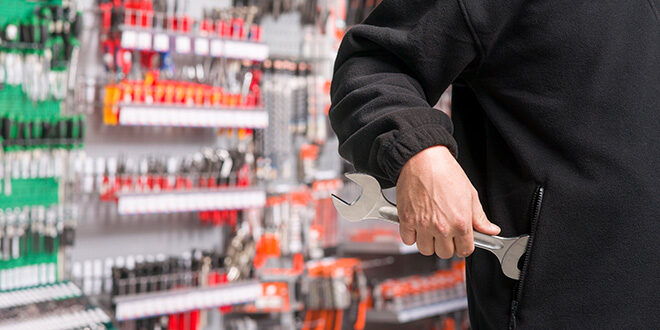According to a recent survey by Coresight Research, retail shrink is getting the attention of consumers, with 26% of respondents indicating they would shop elsewhere if their local store began locking items up. Additionally, 75% of consumers are moderately to extremely concerned that retailers will raise prices to cover the cost of increasing retail theft.
 As retail shrink continues to impact the retail sector, especially small- and medium-size businesses, Hardware Retailing spoke with Christine Fuller, senior loss control representative with Pennsylvania Lumbermens Mutual. Fuller shared expert insights on the basics of loss prevention for the independent channel and the ways home improvement retailers can bolster their strategies against shrink.
As retail shrink continues to impact the retail sector, especially small- and medium-size businesses, Hardware Retailing spoke with Christine Fuller, senior loss control representative with Pennsylvania Lumbermens Mutual. Fuller shared expert insights on the basics of loss prevention for the independent channel and the ways home improvement retailers can bolster their strategies against shrink.
Hardware Retailing (HR): The term “loss prevention” is encompassing, including everything from theft to organized retail crime (ORC) to shrink. Can you provide a brief definition of each?
Christine Fuller (CF): Shrink is retail loss from numerous events or happenings. It refers to all kinds of losses whether it’s cashier error, employee theft, shoplifting, administrative error including audit miscounts, damaged items or vendor theft or errors. It is a general term used in retail to quickly explain a negative number in accounting. Theft can come from employees, vendors or shoplifters. It is a deliberate act by one or more of these individual categories. ORC is a group of people or an organization that targets retail products. This usually happens during the transport of items that are stolen. It can also happen while the items are in storage in a warehouse or the back storage area of the location. Typically, there is an inside employee that provides information to the outside organization as to where the products are, quantity and values. We’ve also seen more of this type of crime in the news lately with mobs of people storming retail environments, overwhelming retail staff, grabbing all that they can and fleeing the scene.
HR: What are some of the ways shrink affects retailers in the independent channel?
CF: These categories of “shrinkage” can and will happen in the retail hardware industry. A retail location’s most prominent loss is theft. This can happen when an employee provides discounts to friends or adds additional products to their friend’s purchase such as an extra bag of mulch or a few more two-by-fours to their load.
Employees can also take items they consider to be small, such as a box of nails or perhaps even bigger items that they feel may be lost inventory. For example, we have seen instances of employees taking power tools that have sat on the back shelf for awhile that they assumed had been forgotten by management. Employees can also steal by ringing a smaller price into the register than the item is worth. This provides them with a receipt and to someone who is not paying attention, payment for the item appears legitimate.
Employee mistakes are also hard-hitting in retail loss. We tend to see miscounting, typos and cashiers not ringing all the items up or ringing in an incorrect price. These are all examples of losses from employee mistakes. Losses also happen when barcodes are not properly entered into the system or when the price on the shelf does not match what is rung up at the register.
Vendors can also create shrinkage. The items they deliver should be counted upon arrival at the facility by management. Open cases can lead to missing items. Invoices can also show more cases than what was delivered, or boxes can be counted twice if the vendor rushes the employee. This can be intentional theft or even just a simple employee mistake.
HR: What has contributed to the recent rise of shrink, theft and organized retail crime?
CF: For the retail hardware industry, an increase of shrinkage can be attributed to many factors, including most prominently the staffing shortage and today’s challenging economic conditions.
The staffing shortage has led to new and improperly trained employees taking on roles or duties they may not have the experience to handle. A cashier may not know the price of a product or may not have the time to research the price. To resolve the matter quickly, especially if customers are waiting, they may simply ring up the item at the wrong—and usually lower—price point. This creates a loss for the retailer. Employees checking in deliveries from vendors may assume the shipment is correct and sign off for the vendor, not realizing the shipment was incorrect. We also see short-term employees who may take items because they don’t feel they were paid enough and won’t be at the job much longer.
The customer may feel prices are much higher than what they paid previously and decide it’s not really stealing if they just purchased a large amount of goods.
HR: In the lumber and hardware industry, which is currently the biggest concern: customer theft, internal fraud or theft of overall shrink?
CF: The biggest concern in the lumber and hardware industry is all of the above. Large losses can occur with just one incident when lumber or power tools are stolen from the facility. Over a year, the same dollar amount of losses can occur through customer theft. Internal theft, depending on the means, can also create large losses. Typically, the smaller the dollar amount of theft means the more often it happens. Any loss is a concern.
HR: Is shrink cyclical? Are there certain societal or cultural factors that impact shrink in either direction?
CF: Shrink is most likely not cyclical since it occurs throughout the year and during various economic cycles. Retail theft is more active during the end of the year holidays, and this could impact hardware retail. Gifts such as power tools and garden tools could be high on a gift list.
Numerous studies show the less economically advantaged the area where a retail location is found, the more likely shoplifting and theft will occur. This does not mean shoplifting will not happen in an economically advantaged area.
HR: How can retailers limit their theft risk? What is the minimum any retailer should be doing to protect themselves?
CF: The key to great loss control is always the same: Accountability, Attitude, Action and Audit.
At minimum, a retailer should have a camera system installed. This will deter most thieves. A good security system should also be in place to prevent after-hour thefts. Well-maintained fencing and locked gates are also important. Retailers should have a professional IT and audit system in place to track inventory and prevent hacking.
Accountability is essential to all loss control, and it also means employees are trained on how to prevent losses, check-in vendors and accept their invoices, check on the bottom of the carts and keep an eye on their customers. One of the key factors to ensure accountability is for managers to hold themselves accountable by training employees accordingly.
Attitude comes in the mentality of everyone in the facility that theft, of any kind, in any amount, is not only unacceptable, but negatively impacts the team. Theft, whether by a vendor, an employee or a customer, should be taken extremely seriously.
Take action to prevent thefts. Install cameras, walk the floor, set up security and ensure staff is always aware of those around them and prepared to act accordingly and safely if they notice any improper activity.
Conducting an audit is more than just a numbers game. Counting inventory isn’t enough, especially if there is a pattern of loss. Managers and employees must also investigate. It’s important to understand how to look for patterns and see what coincides with any ongoing or emerging loss trend. Counting the missing inventory is one thing; understanding how that inventory goes missing can help stop such patterns and eliminate the problem.
HR: What coverage should retailers have in place to protect themselves in case of loss?
CF: Retailers should have both a cyber and theft policy in case of any losses.
HR: Are there ways retailers can advocate for loss prevention?
CF: The local police department is a wonderful place to start. A visible police presence can help prevent crime. A relationship with an officer can provide information on the local community and recent crimes in the area. If there has been a rash of thefts, a retail owner can take more aggressive measures to prevent that location from being part of the crime spree. This is typically the most effective course for most rural and small-town areas and can be helpful in more densely populated areas.
 Hardware Retailing The Industry's Source for Insights and Information
Hardware Retailing The Industry's Source for Insights and Information








